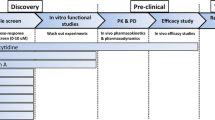Summary
Clinical experience with three vinca alkaloids currently in use as antineoplastic agents has shown a difference in the degree of peripheral neurotoxicity manifested by these compunds: vincristine>vindesine>vinblastine. This phenomenon may reflect differences in pharmacokinetics and/or the differential response of the nerve tissue itself. Differences in pharmacokinetics can be avoided by studying the direct effects of the vinca alkaloids on primary cultures of neuronal and glial cells. Vincristine at a dose as low as 0.004 μg/ml affects the cells with processes in cultures of dissociated newborn rat midbrain. In 3-day-old cultures, after 24 h of drug treatment there is a loss of processes and swelling of the cell body. We have used this observation as the basis for a quantitative assay of the toxicity of a series of vinca compounds, and have found that for a dose range of 0.1–0.004 μg/ml the relative toxicity of vincristine, vinblastine, and vindesine in this system correlates with their relative clinical neurotoxicity. Validation of the predictive elements of this system awaits clinical experience with novel vinca compounds.
Similar content being viewed by others
References
Barnett, C. J., Cullinan, G. J., Gerzon K, Hoying, R. C., Jones, W. E., Newlon, W. M., Poore, G. A., Robinson, R. L., Sweeney, M. J., Todd, G. C., Dyke, R. W., Nelson, R. L.: Structure-activity relationships of dimeric Catharanthus alkaloids. 1. Deacetylvinblastine amide (vindesine) sulfate. J. Med. Chem. 21, 88 (1978)
Burdman, J. A.: A note on the selective toxicity of vincristine sulfate on chick-embryo sensory ganglia in tissue culture. J. Natl. Cancer Inst. 37, 331 (1966)
Donoso, J. A., Green, L. S., Heller-Bettinger, I. E., Samson, F. E.: Action of the vinca alkaloids vincristine, vinblastine, and desacetyl vinblastine amide on axonal fibrillar organelles in vitro. Cancer Res. 37, 1401 (1977)
Dyke, R. W., Nelson, R. L.: Phase I anti-cancer agents: vindesine (desacetyl vinblastine amide sulfate). Cancer Treat. Rev. 4, 135 (1977)
Himes, R. H., Kersey, R. N., Heller-Bettinger, I., Samson, F. E.: The action of vinca alkaloids, vincristine, vinblastine, and desacetyl vinblastine amide on microtubules in vitro. Cancer Res. 36, 3798 (1976)
Hirano, A., Zimmerman, H. M.: Some effects of vinblastine implantation in the cerebral white matter. Lab. Invest. 23, 358 (1970)
Journey, L. J., Burdman, J., Whaley, A.: Electron microscopic study of spinal ganglia from vincristine-treated mice. J. Natl. Cancer Inst. 43, 603 (1969)
Nelson, R. L., Dyke, R. W.: Phase I-II clinical investigation of vindesine (desacetyl vinblastine amide sulfate). Curr. Chemother. 2, 1328 (1978)
Schochet, S. S., Jr., Lampert, P. W., Earle, K. M.: Neuronal changes induced by intrathecal vincristine sulfate. J. Neuropathol. Exp. Neurol. 27, 645 (1968)
Seil, F. J., Lampert, P. W.: Neurofibrillary tangles induced by vincristine and vinblastine sulfate in central and peripheral neurons in vitro. Exp. Neurol. 21, 219 (1968)
Seto, T., Rounds, D. E.: Cultivation of tissues and leukocytes from amphibians. In: Methods in cell physiology. Vol. III, p. 75. New York, Academic Press (1978)
Shelanski, M. L., Wisniewski, H.: Neurofibrillary degeneration induced by vincristine therapy. Arch. Neurol. 20, 199 (1969)
Sweeney, M. J., Boder, G. B., Cullinan, G. J., Culp, H. W., Daniels, W. D., Dyke, R. W., Gerzon, K., McMahon, R. E. Nelson, R. L., Poore, G. A., Todd, G. C.: Antitumor activity of deacetyl vinblastine amide sulfate (vindesine) in rodents, and mitotic accumulation studies in culture. Cancer Res. 38, 2886 (1978)
Varon, S.: Neural cell isolation and identification In: Cell, tissue, and organ cultures in neurobiology, p. 237. New York: Academic Press (1977)
Weiss, H. D., Walker, M. D., Wiernik, P. H.: Neurotoxicity of commonly used antineoplastic agents (second of two parts). N. Engl. J. Med. 291, 127 (1974)
Wilson, L.: Microtubules as drug receptors: pharmacological properties of microtubule protein. Ann. NY Acad. Sci. 253, 213 (1975)
Author information
Authors and Affiliations
Rights and permissions
About this article
Cite this article
King, K.L., Boder, G.B. Correlation of the clinical neurotoxicity of the vinca alkaloids vincristine, vinblastine, and vindesine with their effects on cultured rat midbrain cells. Cancer Chemother. Pharmacol. 2, 239–242 (1979). https://doi.org/10.1007/BF00257187
Received:
Issue Date:
DOI: https://doi.org/10.1007/BF00257187




